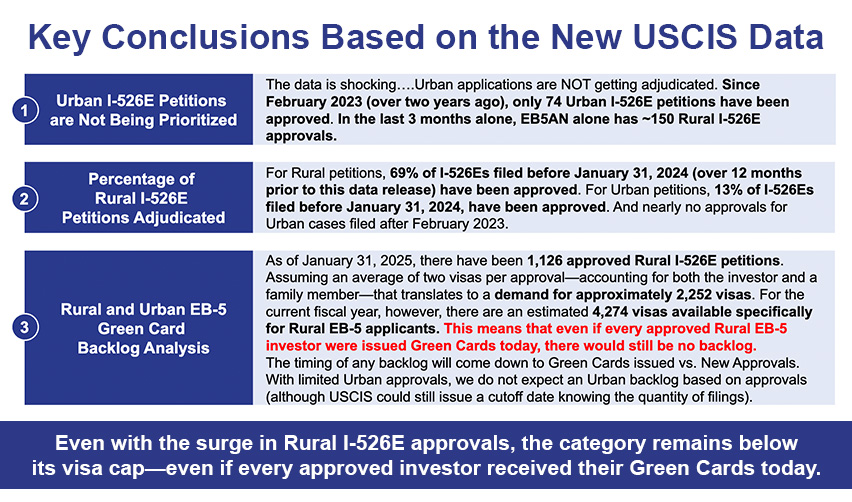New data has now confirmed EB5AN’s data-driven forecasts: Rural investments are the fastest path to an EB-5 Green Card.
For the first time since the EB-5 Reform and Integrity Act of 2022 (RIA) was passed, data is available from United States Citizenship and Immigration Services (USCIS) that shows I-526E filings and adjudications. The data coverage is extensive—spanning from April 2022 just after the RIA was passed through January 2025—and provides valuable new insights into how rural and urban I-526E petitions are being processed by USCIS under the RIA.
The single most important takeaway from this new data is how USCIS is handling rural filings. Under the RIA, rural I-526E petitions are supposed to receive priority processing. But it has been unclear what that would look like in practice.
Now we know.
Rural I-526E petitions are seeing a high volume of fast approvals. Urban filings, on the other hand, are being reviewed much more slowly, and far fewer have been processed.
This data also shows that the volume of rural approvals has not decreased under the Trump administration in 2025. Instead, EB5AN is seeing approval times continue to go down for its rural EB-5 investors. For investors concerned about the Trump administration, this data provides useful context. Despite any rhetoric or proposed policies, the EB-5 program, especially rural investment, continues to be a viable path to a Green Card.
On May 21, 2025, EB5AN held a webinar to address this new data. In this presentation, EB5AN’s managing partners Sam Silverman and Mike Schoenfeld and EB5AN’s VP Ahmed Khan discussed the remarkable approval rates for rural I-526E filings. They also explained the implications of the new data, both for existing EB-5 investors and for prospective investors choosing between rural and urban EB-5 projects.
At EB5AN, we aim to help EB-5 investors make informed decisions. To learn more about this data, what it means, and how it may impact you, watch the full-length webinar or the highlights video—or read the summary below.
Watch Full Webinar
Watch Webinar Highlights
Overview of Recent I-526E Petition Data
Analyzing the Data
- I-526E Approval Rates at Historic Highs
- I-526E Receipts Outpacing Adjudications by Far
- Rural I-526E Adjudications Being Given Clear Priority
- Urban I-526E Adjudications at Standstill Since February 2023
- EB5AN’s Investors Represent a Significant Share of Approvals
Internal EB5AN Data Shows Approval Times Trending Down
Implications of Data on Approval Times
Implications of Data on Backlog Risks
Strategic Considerations for EB-5 Investors
Overview of Recent I-526E Petition Data
USCIS has released new data in response to Freedom of Information Act (FOIA) requests by the American Immigrant Investor Alliance (AIIA) and The Galati Law Firm. This latest data provides the most comprehensive look at how USCIS is processing I-526E petitions since the RIA was passed into law.
This new data adds to a growing body of recent data from USCIS. Taken as a whole, the data provides a clear picture of I-526E filing volume, investor demographics, and adjudication rates.
First, recent data shows I-526E receipts by visa category and by country. In this context, the term “receipts” refers to petitions that have been filed by EB-5 investors and received by USCIS. Form I-526E receipts through January 31, 2025, are shown in the following graphic:
Through January 2025, USCIS received a total of 9,878 I-526E filings. The number of filings in the high-unemployment (urban) category totaled 5,191, while filings in the rural category totaled 4,329. Other filings accounted for the remaining 358.
For the first two years or so after the RIA was passed, urban filings outpaced rural by a ratio of nearly two to one. This was in part because the rural visa category did not exist before the RIA, and it took some time for the market to adjust. Investors also needed time to learn about the rural category and why they might choose it over urban.
But the market has changed. Over the last 18 months, rural filings have surged. By January 2025, urban filings made up only about 40% of the total. Rural filings, meanwhile, had risen to nearly 58%.
Early assumptions by some in the EB-5 industry were that urban projects would dominate the market. The data has now dispelled that notion.
For China—the largest source of EB-5 investment—the number of rural petitions filed since April 2022 has surpassed urban filings and now accounts for 52% of total filings from that country. For India—the second-largest source of EB-5 investment—the number of rural filings has grown to represent 47% of the total. And applicants from the rest of the world have likewise shifted toward rural.
This trend likely reveals a growing awareness of the benefits of rural under the RIA. It may also reflect uncertainty with regard to the last U.S. election and the new Trump presidency. EB5AN’s internal data, for instance, shows a sharp increase in filings since January 2025. Whatever the reason, the data shows strong and growing investor preference for rural projects.
But this latest data does more than confirm the growing preference for rural among EB-5 investors. It also shows detailed EB-5 adjudication statistics for the first time since the RIA was passed.
The following graphic outlines I-526E approval rates from April 1, 2022, through January 31, 2025. On the left, the data is broken down by visa category. On the right, the data is divided by country.
Importantly, this new data has given the EB-5 industry its first look at how USCIS is actually processing I-526E petitions under the RIA. By analyzing this data, we can better understand I-526E approval timelines, potential delays, and EB-5 visa backlog growth.
In the following sections, we provide a careful analysis of the new data. In doing so, our aim is to equip EB-5 investors with the information they need to make the best decision for them and their families. As always, we encourage investors to discuss their options with their immigration attorneys.
Analyzing the Data
I-526E Approval Rates at Historic Highs
Approval rates for I-526E petitions are at about 97%, which is far above historical norms. For context, pre-RIA Form I-526 petitions have typically seen approval rates of less than 75%.
We suspect this figure will come down some since pending requests for evidence (RFEs) and notices of intent to deny (NOIDs) are not shown in the data.
Even accounting for that bias, the high approval rate suggests that the reforms brought about by the RIA have been successful. Clearer standards have helped applicants know what they need to provide and helped USCIS be more consistent in their reviews.
I-526E Receipts Outpacing Adjudications by Far
One clear insight from the new data is that a vast and growing gap has formed between I-526E receipts and adjudications. As of January 31, 2025, a total of 9,520 rural and urban petitions were filed, but only a fraction—about 16%—had been adjudicated.
This gap between the number of I-526Es received and the number processed has a couple notable implications. First, at the current rate that I-526E petitions are being approved, it seems unlikely that visa limits will be reached in any category in the near future. Second, with filing rates as high as they have been, a backlog is forming—but it has not yet resulted in cut-off dates most likely because processing rates are low.
We will examine these points in more detail below.
Rural I-526E Adjudications Being Given Clear Priority
The key revelation from the new data is how USCIS is implementing priority processing for rural Form I-526E petitions.
Through January 31, 2025, USCIS processed roughly three times the number of rural petitions compared to urban. The chart below shows the total number of rural and urban Form I-526E petitions and how many of each have been adjudicated. The difference is shocking.
From April 2022 to January 2025, only 361 urban petitions were processed, amounting to about 7% of the 5,191 urban filings. In that same time, over 1,100 rural petitions were processed, equating to around 27% of the 4,329 rural filings. So not only did USCIS process almost three times as many rural petitions—it did so despite having received about 20% more urban than rural petitions.
This stark difference in rural and urban processing shows that USCIS is prioritizing rural as required by the RIA. And this prioritization is not a recent anomaly. The data shows an even growing focus on rural processing over the past 24 months.
Overall, since the RIA requires USCIS to prioritize rural I-526E petitions, we expected these results—to an extent. What we did not know is how much rural priority processing would impact urban I-526E processing, which we look at in more detail next.
Urban I-526E Adjudications at Standstill Since February 2023
By around February 2023, the EB-5 market had begun to adjust to the new rural and urban project categories. And if you look at the data from February 1, 2023, to January 31, 2025, the difference in rural and urban processing is even more pronounced.
As shown on the right side of the previous chart, USCIS adjudicated 967 out of 4,095 rural petitions but only 74 out of 4,521 urban petitions. In other words, USCIS adjudicated only 1.5% of urban I-526E petitions from February 2023 to January 2025. By contrast, USCIS processed about 24% of rural filings in that same time.
Note that the adjudication ratio during this period is 13:1 in favor of rural.
These numbers make it seem like USCIS has all but stopped processing urban I-526E petitions. In fact, we have reason to believe that many, if not most, of the urban petitions adjudicated in recent months are the result of legal action, not the standard adjudication process.
EB5AN’s Investors Represent a Significant Share of Approvals
While the new data from USCIS is interesting by itself, it also provides context for EB5AN’s internal data. By comparing approval data from EB5AN’s projects with the data overall, we can better understand how our projects have fared in the market.
As shown in the image below, roughly 20% of all rural approvals in the past two years have been for investors in our projects. This share exceeds our proportion of filings, which suggests our focus on project and document quality has had a positive impact on I-526E processing for our clients.
Internal EB5AN Data Shows Approval Times Trending Down
As mentioned above, the new USCIS data shows approvals through the end of January 2025. In the months since, EB5AN’s internal data indicates that rural I-526E processing is accelerating.
At the end of January, USCIS had approved 1,126 rural petitions. Of that total, EB5AN’s investors accounted for 208 approvals. By mid-May, however, EB5AN’s investors had received 360 approvals. Thus, in the last four months, our internal data indicates an increase in adjudications of over 70%.
The following graphic shows USCIS approval data compared to EB5AN’s internal data. It also uses EB5AN’s internal data, which is current, to estimate the number of approved I-526Es across the EB-5 industry.
The increased rate of rural processing we see in our data challenges anecdotal reports of slower processing under the new Trump administration. Contrary to these reports, we suspect our data reflects an industry-wide trend and that rural processing has sped up significantly.
Put simply, average processing times are getting faster. What has been taking almost a year is now taking eight to 10 months.
Implications of Data on Approval Times
One benefit of this new data is it lets us track the difference between how many petitions have been received and how many have been adjudicated from month to month. This gives a strong indicator of I-526E processing times. And because the new data is broken down by visa category, we can assess the difference in rural and urban processing times.
USCIS is clearly prioritizing rural petitions. On the other hand, for the most part, urban petitions appear to be stuck in the queue. How, then, does this impact approval timelines?
Some in the industry have suggested that urban I-526E processing is taking only slightly longer than rural—or that rural and urban processing times have been about the same. Until now, the data simply was not available to either prove or disprove these claims. The new data, however, provides a definitive answer.
Rural petitions are being processed quickly—typically in one year or less. Urban petitions are hardly being processed at all, and the data does not even allow for an accurate estimate of urban approval times. As a result, in most cases, we expect that rural investors will receive their U.S. Green Cards much sooner than urban investors.
Implications of Data on Backlog Risks
Backlogs occur when the demand for visas is greater than the number of visas available. While the number of Form I-526E approvals remains far below the number of available EB-5 visas, the high number of pending petitions suggests a backlog could be announced by USCIS soon.
As filing numbers continue to rise, so does the potential for a backlog. For the urban category in particular, if Form I-526E receipts remain steady and USCIS processing does not increase, the risk of a sudden backlog will grow.
When a backlog takes effect, a cut-off date is published on the monthly Visa Bulletin. Only investors whose petitions were filed before the current cut-off date may apply for an EB-5 visa.
Whenever their cut-off date is or becomes current, applicants must still complete consular processing or adjust their status to receive their Green Cards.
Strategic Considerations for EB-5 Investors
If you have already invested in an urban EB-5 project, you may want to explore filing a mandamus in an effort to have your I-526E petition adjudicated—since standard processing is, at best, producing a small handful of approvals. The data does not yet indicate how long urban I-526E petitions will take to process, and a legal writ may be the only way to move your application forward—but it carries additional costs and procedural risks. You should consult your immigration counsel to see whether filing a mandamus makes sense in your case.
If you are considering an EB-5 investment, you should carefully evaluate the backlog risks of each visa category. As of right now, urban filings are current. But thousands of pending petitions may force USCIS to declare a backlog and set a cut-off date. Filing an urban petition while the category remains current gets you in the queue, but it does not eliminate the risk of delays in obtaining a Green Card. If you are already in the United States, however, you may be able to concurrently file for adjustment of status, work authorization, and a travel permit.
Rural, by contrast, enjoys priority processing and has twice as many annual set-aside visas compared to urban. With approval times trending toward eight to 10 months and less than half of its visas claimed, the rural category is much less likely to face delays—even if filings or approvals were to surge.
For more information on this data or how a rural EB-5 investment offers you a faster path to a Green Card, schedule a free consultation with EB5AN.












